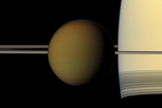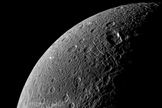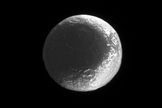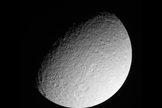
The comparitive sizes of some of Saturn’s biggest moons are shown.
Credit: NASA/JPL/David Seal
At least 62 moons travel around Saturn. They come in a variety of sizes and compositions, from almost pure ice to rocky material, as well as a combination of both. Their journeys around the ringed planet range from half an Earth day to just over four Earth years.
One of Saturn’s moons, Titan, makes up 96 percent of the mass orbiting the planet. Scientists think that Saturn’s system may have originally housed two such moons, but the second broke up, creating the debris that formed the rings and smaller, inner moons. Another theory suggests that the system originally housed several large moons, similar to Jupiter’s Galilean moons , but two fused into Titan. The violent collision could have scattered the debris that would have later drawn together into the smaller moons.

The colorful globe of Saturn’s largest moon, Titan, passes in front of the planet and its rings in this true color snapshot from NASA’s Cassini spacecraft. The north polar hood can be seen on Titan (3,200 miles or 5,150 kilometers across) and appears as a detached layer at the top of the moon here. Image released Dec. 22, 2011.
Credit: NASA/JPL-Caltech/Space Science Institute
Some of the moons travel inside the gaps of the rings, clearing paths through the debris. Others orbit farther out. Several of the moons interact with one another, with their orbits moving in resonance with each other. Larger moons may trap smaller moons, keeping them nearby. Sixteen of the moons are tidally locked, with one face permanently turned toward Saturn.
The first moon was discovered in 1655. Over the next 200 years, the other seven major satellites were spotted. By 1997, astronomers on Earth had found 18 moons in orbit around the planet. The close orbit of NASA’s Cassini mission , along with advances in technology for Earth-based telescopes, enabled the discovery of the rest.
In 1847, British astronomer Sir John Herschel suggested that the moons of Saturn take their names from the Titans. The mythical siblings of the Greek god Cronus — Saturn to the Romans — the Titans battled the Olympian gods and lost. Once the names of the Titans were used, the moons began to be called after other characters from Roman and Greek mythology. Only 53 of Saturn’s moons have names; the rest are identified by a numerical designation relating to their year of discovery. [PHOTOS: The Rings and Moons of Saturn ]
Let’s look at the eight major moons of Saturn:
Titan
Titan is the largest of Saturn’s moons and the first to be discovered. Titan is the only moon in the solar system known to have a significant atmosphere. Nitrogen and methane extend around the moon 10 times as far into space as Earth’s atmosphere, sometimes falling to the surface in the form of methane rain. This atmosphere makes it one of the best potential candidates for hosting life. Titan is larger than the planet Mercury , though not nearly as massive. It hosts many hydrocarbon-filled lakes as well as extremely tall mountains, with the largest one rising to nearly 11,000 feet . This moon is the only one to have a landing craft arrive on its surface, when the Cassini mission sent the Huygens lander there in 2005.

Wispy terrain reflects sunlight brightly in the lower left of this Cassini image of the northern latitudes of Saturn’s moon Dione. Image taken December 20, 2010.
Credit: NASA/JPL/Space Science Institute
Dione
Dione is thought to be a dense rocky core surrounded by water-ice. The tidally locked moon is heavily cratered not on its leading side but on its back side. Astronomers think a collision could have spun the moon on its axis. The moon hosts a thin oxygen atmosphere and may have a liquid ocean beneath its surface .
Enceladus
Enceladus contains more than 100 geysers at its south pole. Tidal heating causes portions of the icy planet to melt, spewing icy material into space from its “tiger stripes.” The tiny bits of ice travel together to create Saturn’s E ring. The satellite’s icy surface makes it one of the brightest objects in the solar system. The moon has a subsurface ocean that may be friendly to life.
Hyperion
Hyperion was the last of the major satellites to be discovered. Hyperion is a small moon with an irregular appearance. The flattened object resembles an elongated potato rather than a sphere, a form that may have been created when an impact demolished a larger moon long ago. Hyperion has a spongy shape, possibly due to its low density and porous surface. Impacts seem to be absorbed by the moon, and most of the ejecta is thrown into space.

The equatorial ridge of Iapetus can reach heights of up to 12 miles (20 km). This image reveals mountains only about half that height.
Credit: NASA/JPL/Space Science Institute
Iapetus
Iapetus features light and dark contrasts on its surface, giving the moon a yin-yang shape. Dark hydrocarbons falling to the moon long ago, perhaps from the nearby moon Phoebe, may have had more time to absorb more heat, gradually growing and spreading over time. Iapetus has a walnut-like shape, with its center bulging outward, and a ridge running around its equator. The moon also contains some of the highest mountains in the solar system, which may have been material from another moon . Scientists are studying ice movements (such as landslides) to do comparative work with these types of features on Earth.
Mimas
Mimas has a gaping crater that gives the rocky moon a strong resemblance to fictional Death Star in the “Star Wars” movies. The impact stands out despite the fact that Mimas is one of the most heavily cratered bodies in the solar system, with overlapping impacts covering the surface. The smallest and closest orbiting of Saturn’s major moons, Mimas cleared the gap known as the Cassini division between two of the planet’s rings. Mimas is made up primarily of water-ice, but despite its proximity to the planet (and the resulting tidal heating that should occur), the surface of the moon remains unchanged; none of the ice seems to be melting, though such melting occurs on other, more distant moons. It is possible that there is a liquid ocean beneath its surface , although scientists say that an oval-shaped core could also explain some of Mimas’ libration movements.

This raw image of Saturn’s icy moon Rhea was taken on March 10, 2013 by NASA’s Cassini spacecraft, and received on Earth March 10, 2013. The camera was pointing toward Rhea at approximately 174,181 miles (280,317 kilometers) away.
Credit: NASA/JPL/Space Science Institute
Rhea
Rhea is a heavily cratered moon and lacks a core at its center. Instead, the entire body is composed of ice, with traces of rock mixed in, causing it to resemble a dirty snowball. The second largest of the planet’s major moons, Rhea is still rather small, about half the size of Earth’s moon. The satellite contains a faint oxygen atmosphere, about 5 trillion times less dense than the one found on Earth, but the only known oxygen atmosphere in the solar system. Radiation from Saturn’s magnetosphere could release oxygen and carbon dioxide from the icy surface.
Tethys
Tethys travels close to Saturn and feels the gravitational pull of the planet. The heat from Saturn may allow the moon’s icy surface to melt slightly, filling in craters and other signs of impact. Made up almost entirely of water ice, the surface is highly reflective. A large trench crosses the moon, running diagonally from its north to south pole and spanning three-quarters of the satellite’s circumference. A large crater on the other side of the moon covers nearly two-fifth of the moon’s diameter and is nearly the size of Mimas. Scientists have found strange red arcs on the moon and are still struggling to explain how the arcs got there.
The minor moons
The smaller named moons of Saturn are as follows:
| 9. Erriapus 10. Phoebe 11. Janus 12. Epimetheus 13. Helene 14. Telesto 15. Calypso 16. Kiviuq 17. Atlas 18. Prometheus 19. Pandora 20. Pan |
21. Ymir 22. Paaliaq 23. Tarvos 24. Ijiraq 25. Suttungr 26. Mundilfari 27. Albiorix 28. Skathi 29. Siarnaq 30. Thrymr 31. Narvi 32. Methone |
33. Pallene 34. Polydeuces 35. Daphnis 36. Aegir 37. Bebhionn 38. Bergelmir 39. Bestla 40. Farbauti 41. Fenrir 42. Fornjot 43. Hati |
44. Hyrrokkin 45. Kari 46. Loge 47. Skoll 48. Surtur 49. Greip 50. Jarnsaxa 51. Tarqeq 52. Anthe 53. Aegaeon |
The unnamed moons, identified by year of discovery, are:
| 1. S/2004 S7 2. S/2004 S12 3. S/2004 S13 |
4. S/2004 S17 5. S/2006 S1 6. S/2006 S3 |
7. S/2007 S2 8. S/2007 S3 9. S/2009 S1 |
— Additional reporting by Elizabeth Howell, Space.com contributor
Comments are closed.